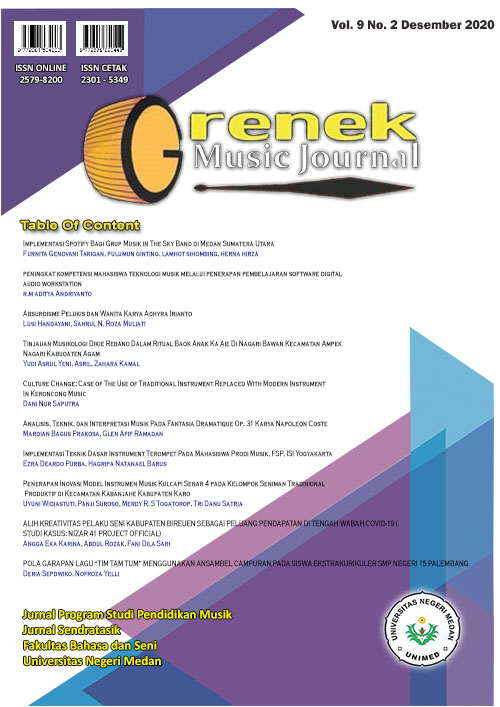TINJAUAN MUSIKOLOGIS DIKIE RABANO DALAM RITUAL BAOK ANAK KA AIE DI NAGARI BAWAN KECAMATAN AMPEK NAGARI KABUPATEN AGAM
Main Article Content
Abstract
The study aims to discuss dikie rabano™s function in the context of the baok anak ka aie (shower down) ritual and to discuss the form of the presentasion of dikie rabano in the care-bathing ritual at Nagari Bawan. The research methods use are qualitative methods with data collection techniques: observastion, interviews, and documentation. As a result of the study, dikie rabano™s function was that of both customary and religious education and of promoting a grammatical relationship between the family and surrounding communities. In terms of the presentation, there is an art in dikie rabano that begins with vowels or song solo and instructed by the vocal group together while playing rabano™s instrument rhythm pattern, whereas in terms of its musical shape, it can be seen as a continuous rhythm pattern.
Article Details
Section
Grenek Music Journal

This work is licensed under a Creative Commons Attribution-ShareAlike 4.0 International License.
Authors published with the Grenek: Jurnal Seni Musik agree to the following terms:
- Authors retain copyright and grant the journal the right of first publication with the work simultaneously licensed under a Creative Commons Attribution License (CC BY-SA 4.0) that allows others to share the work with an acknowledgment of the work's authorship and initial publication in this journal.
- Authors are able to enter into separate, additional contractual arrangements for the non-exclusive distribution of the journal's published version of the work (e.g., post it to an institutional repository or publish it in a book), with an acknowledgment of its initial publication in this journal.
- Authors are permitted and encouraged to post their work online (e.g., in institutional repositories or on their website) prior to and during the submission process, as it can lead to productive exchanges, as well as earlier and greater citation of published work. (See The Effect of Open Access)
